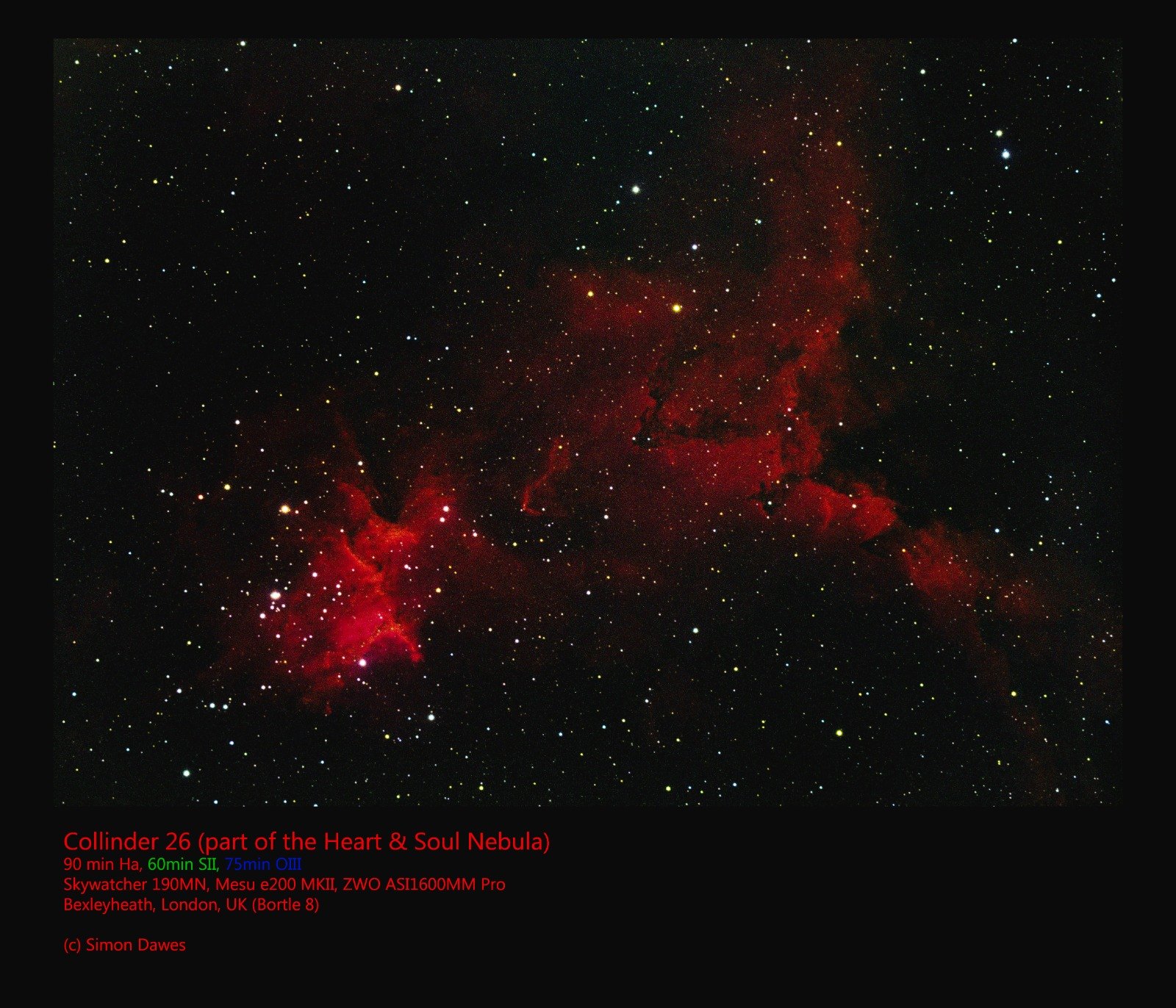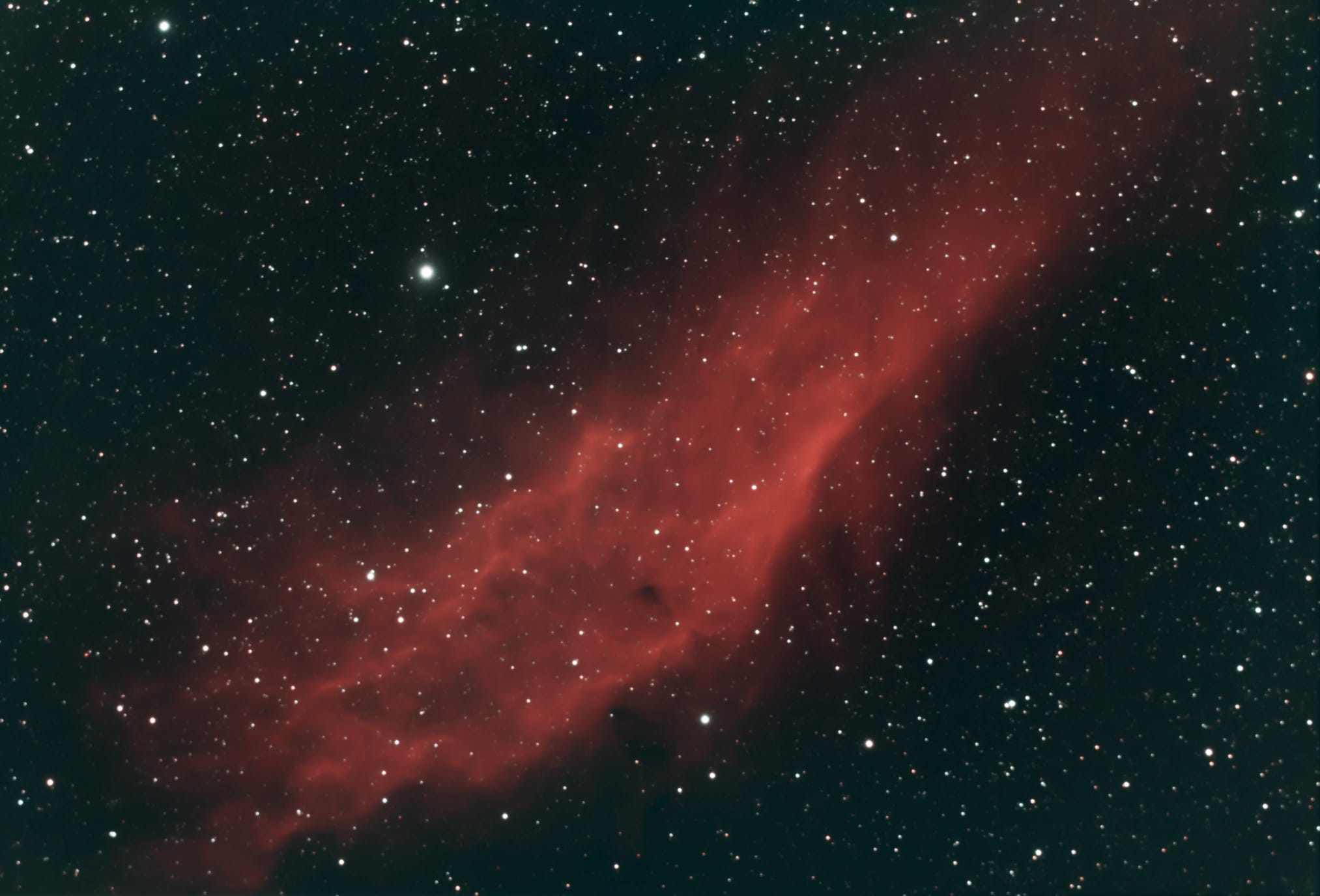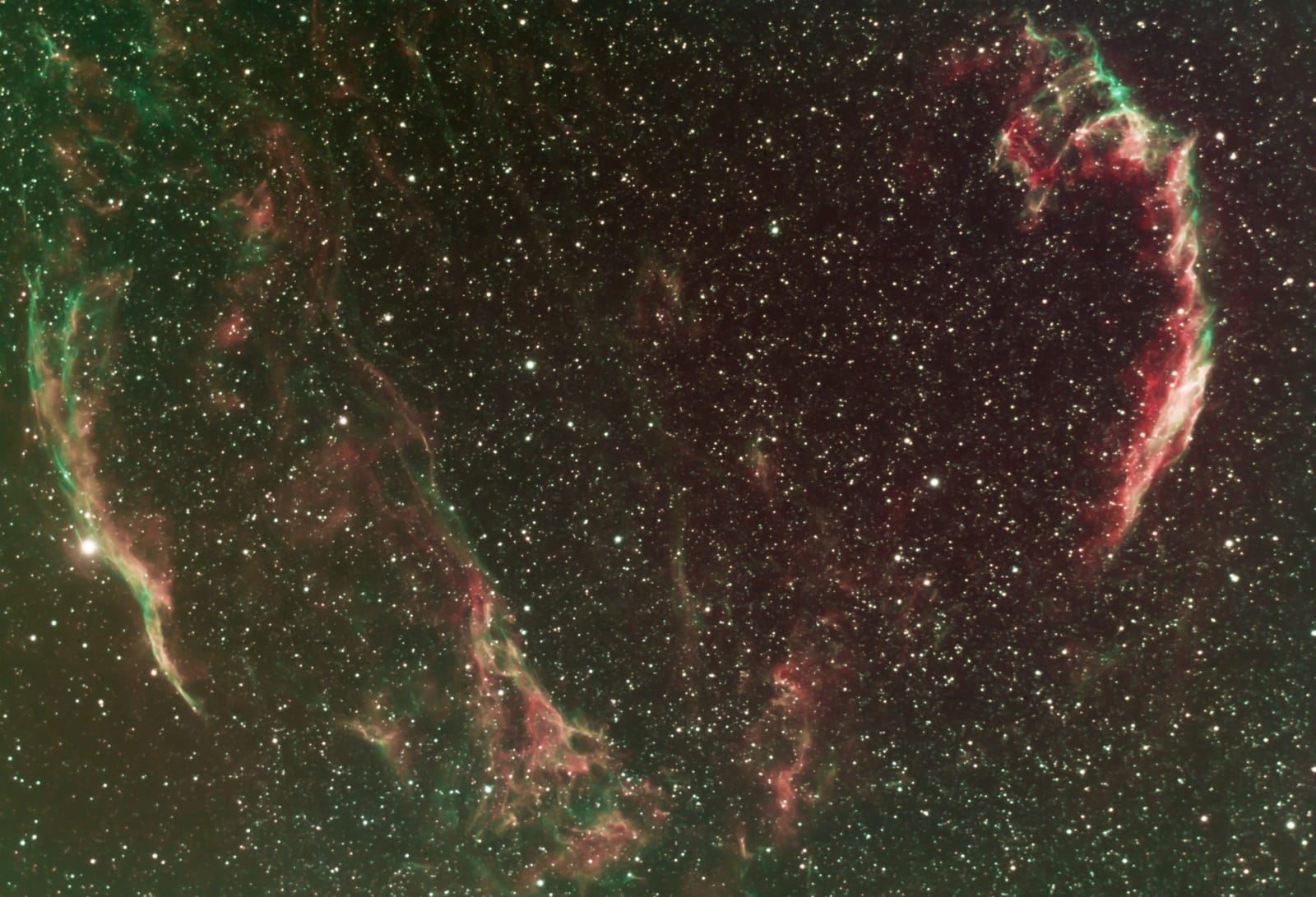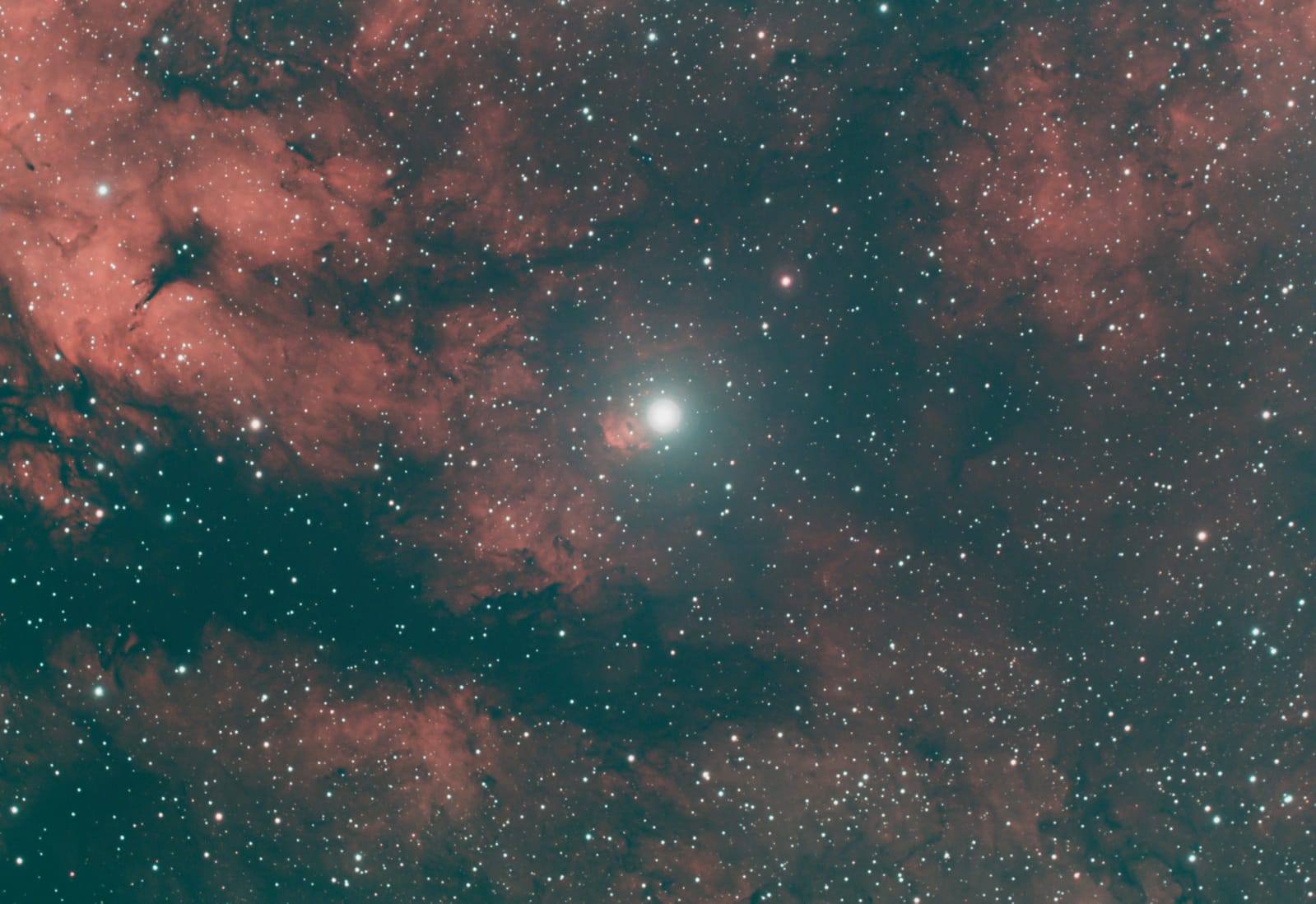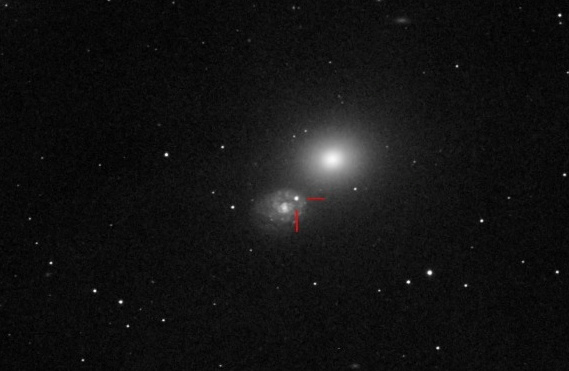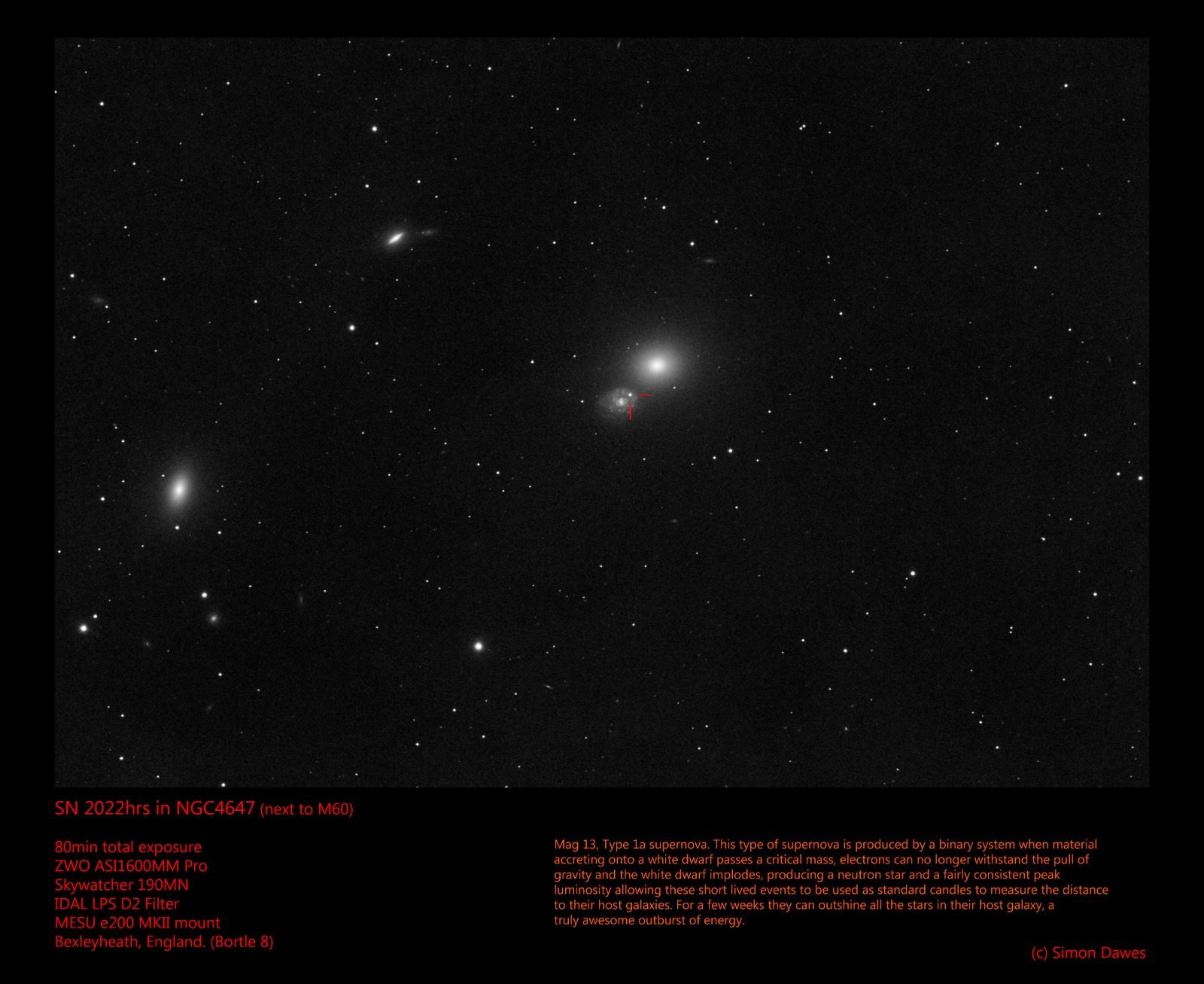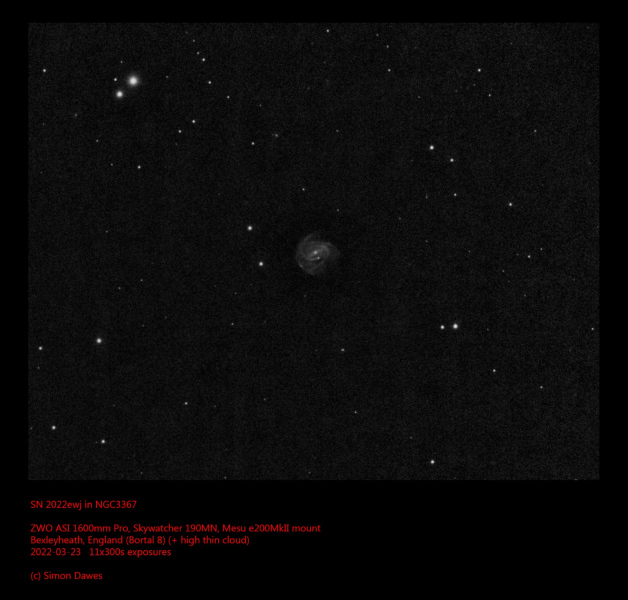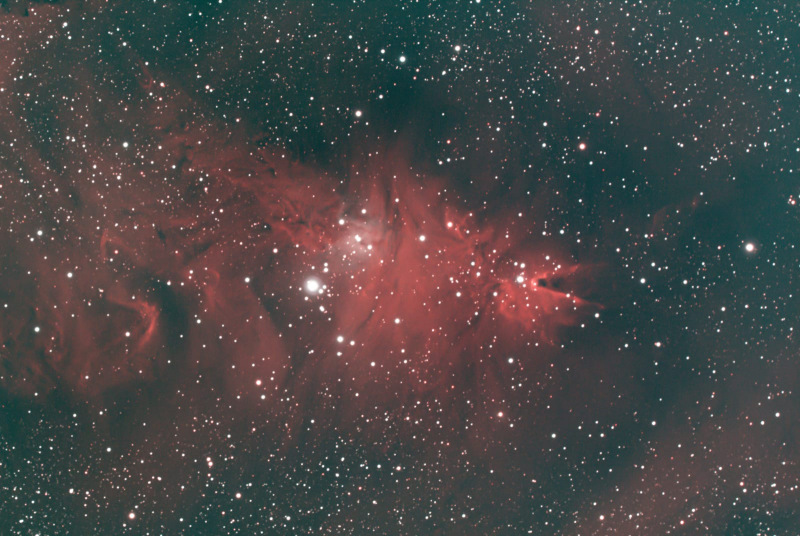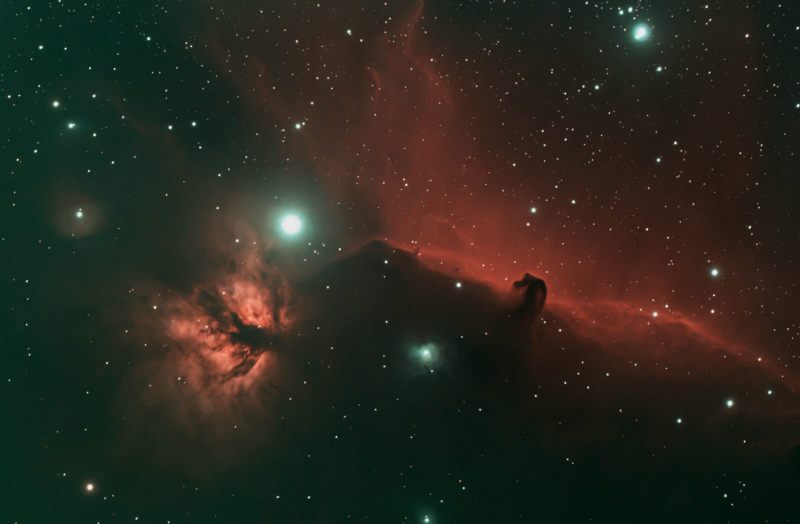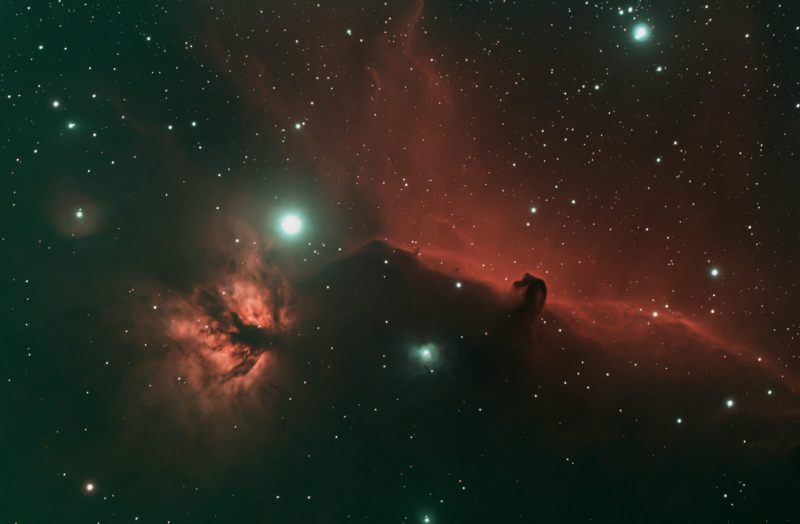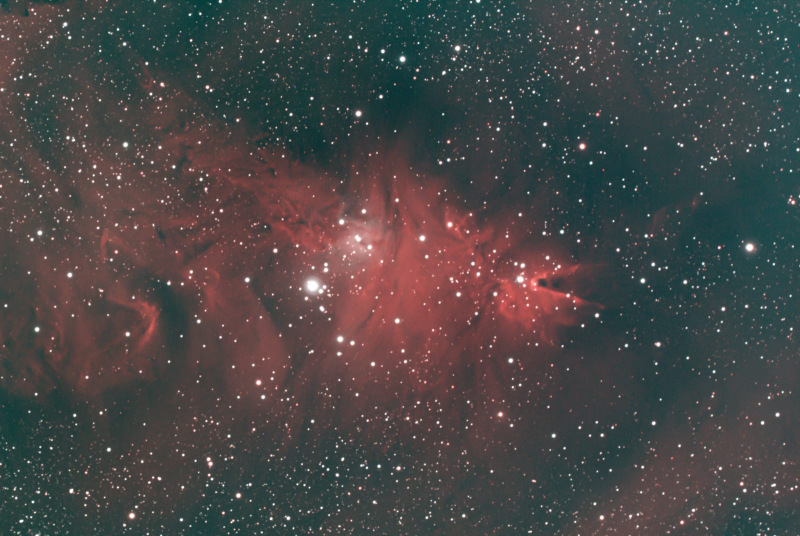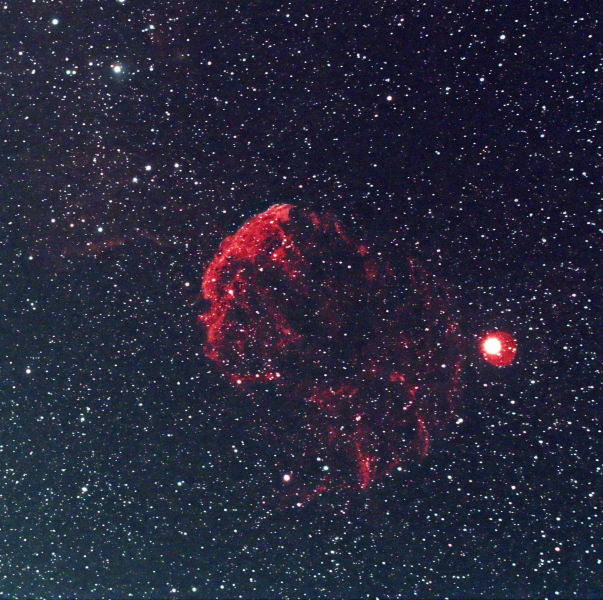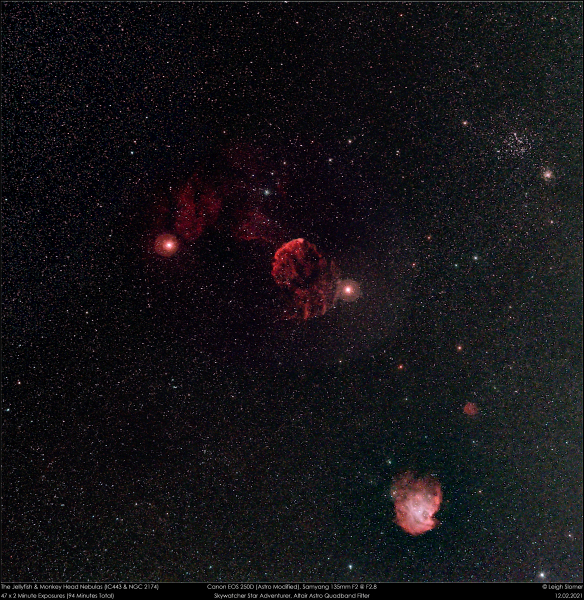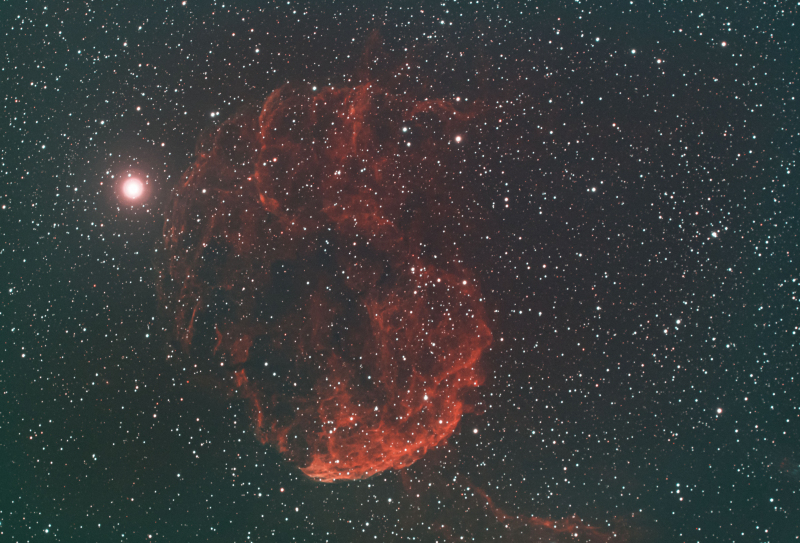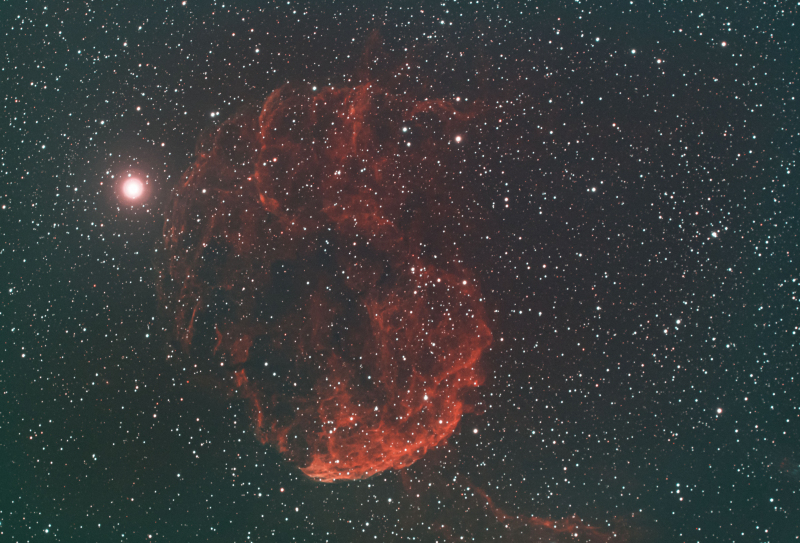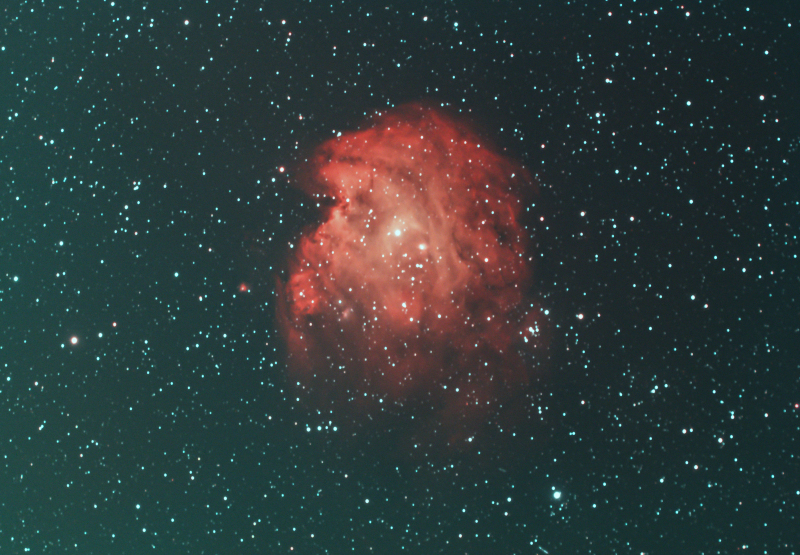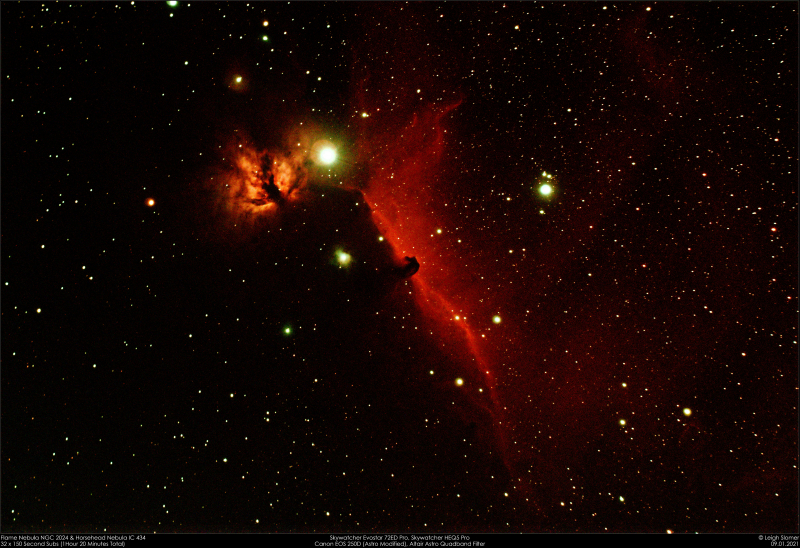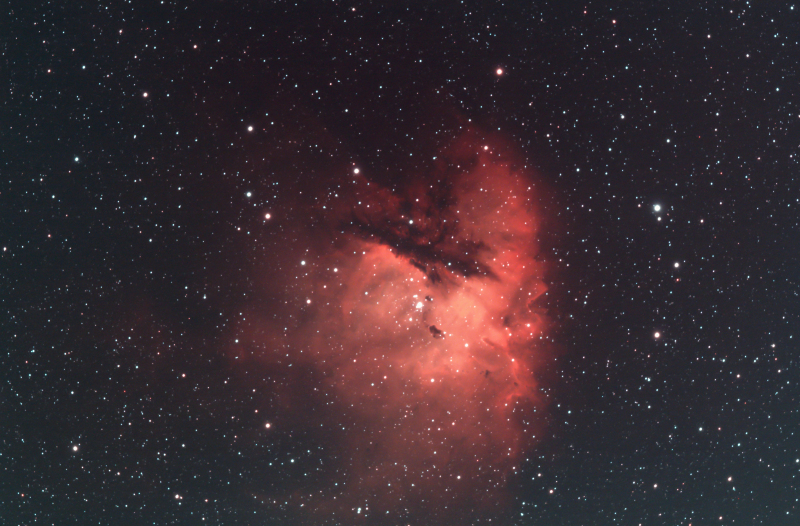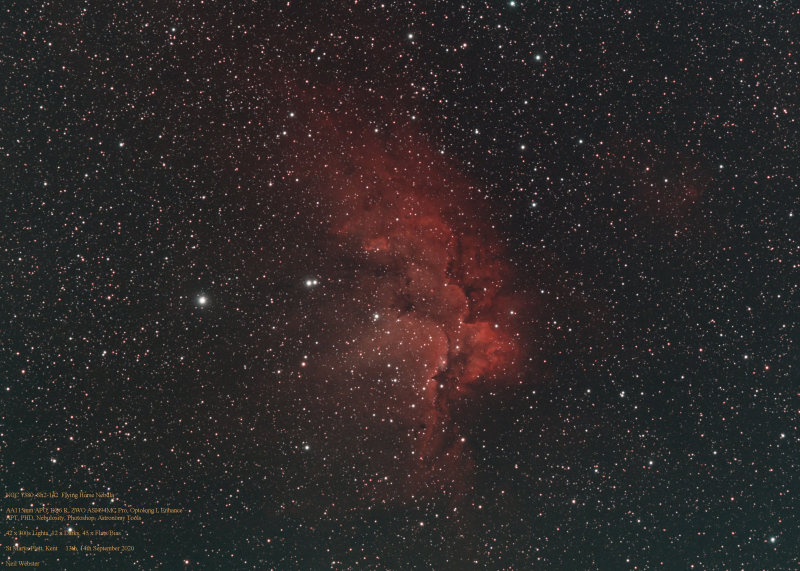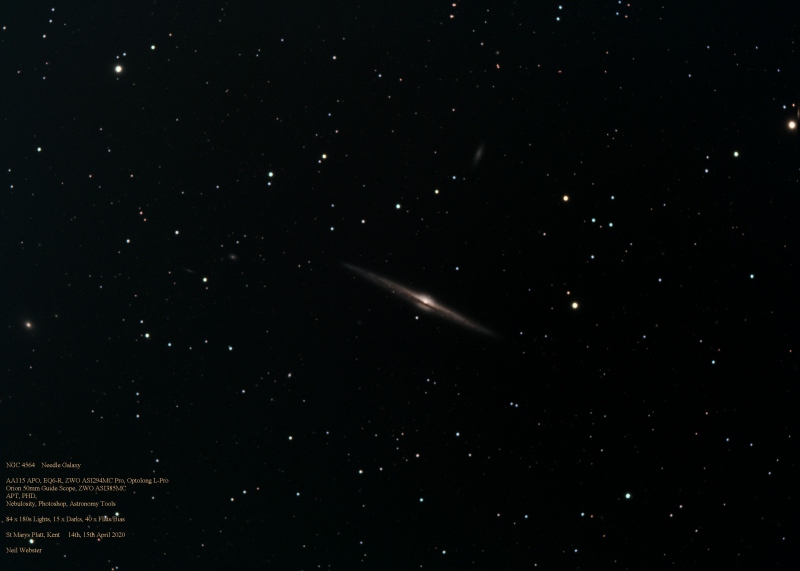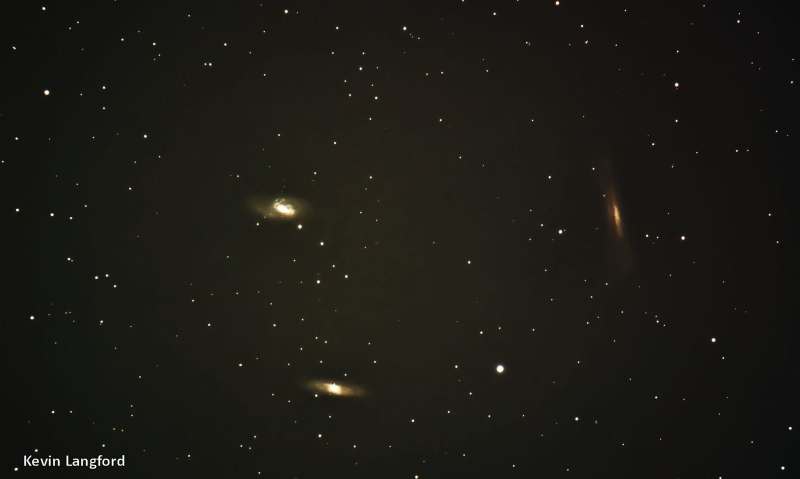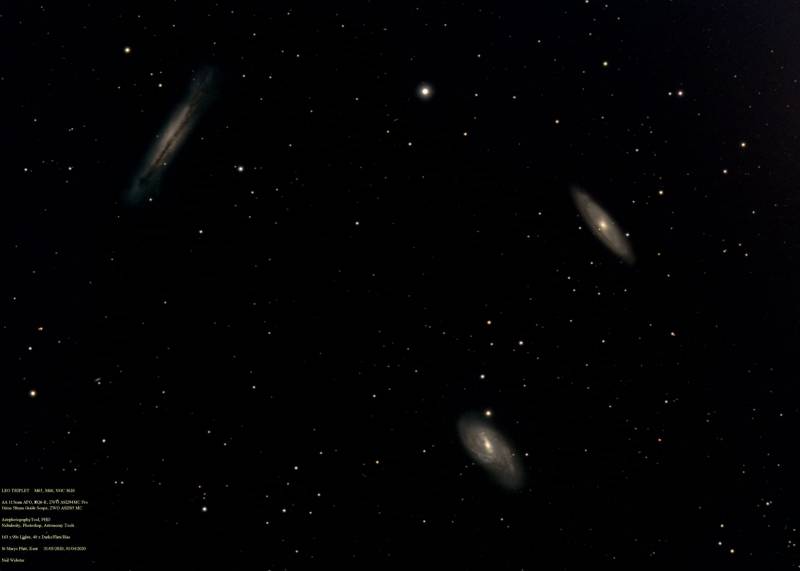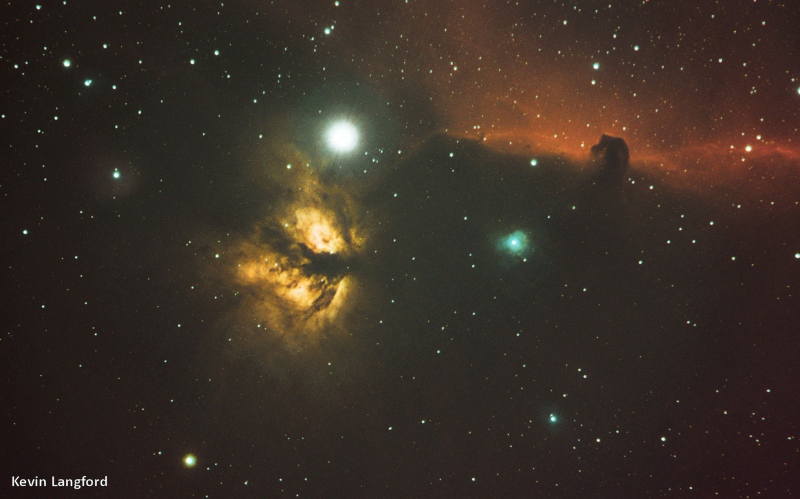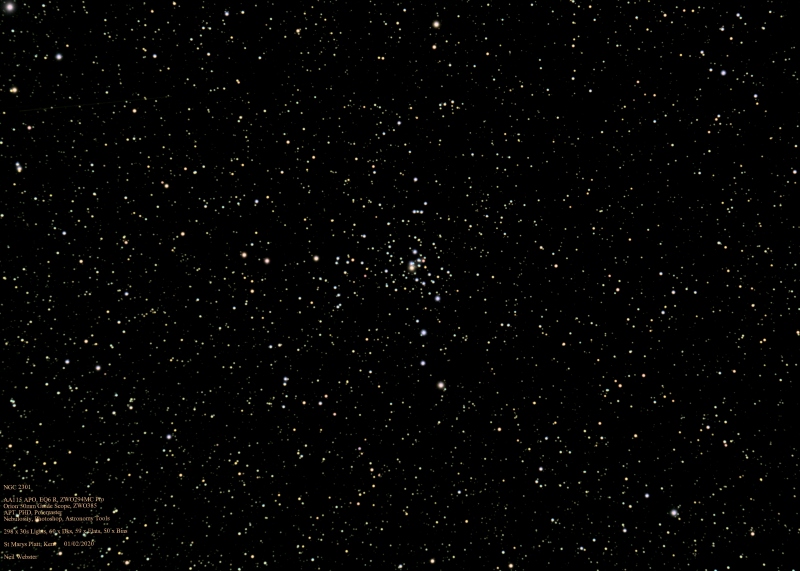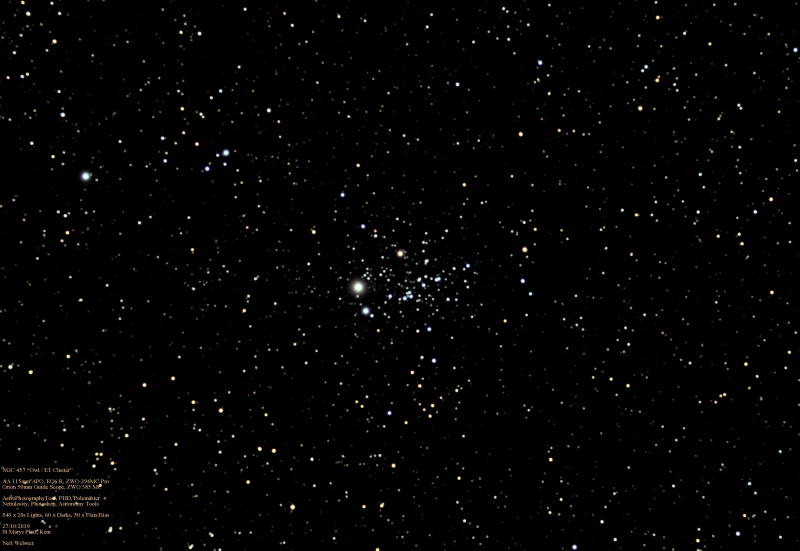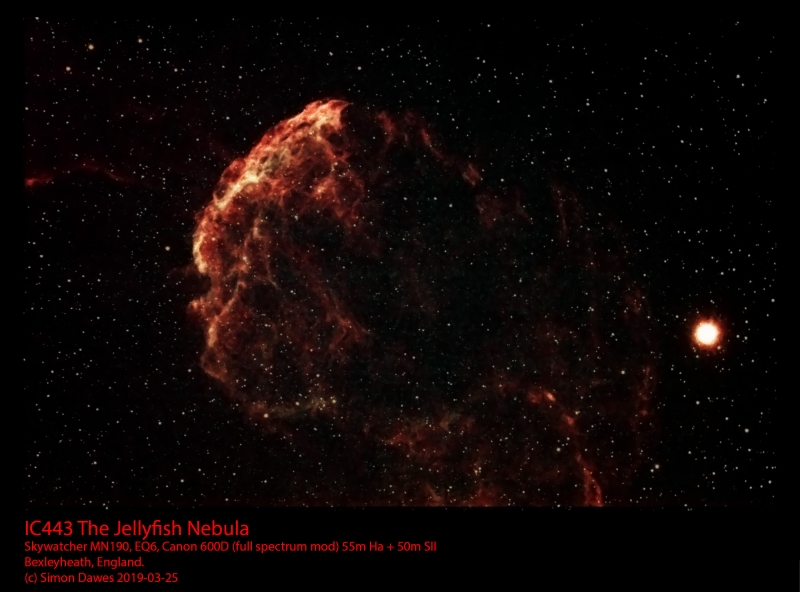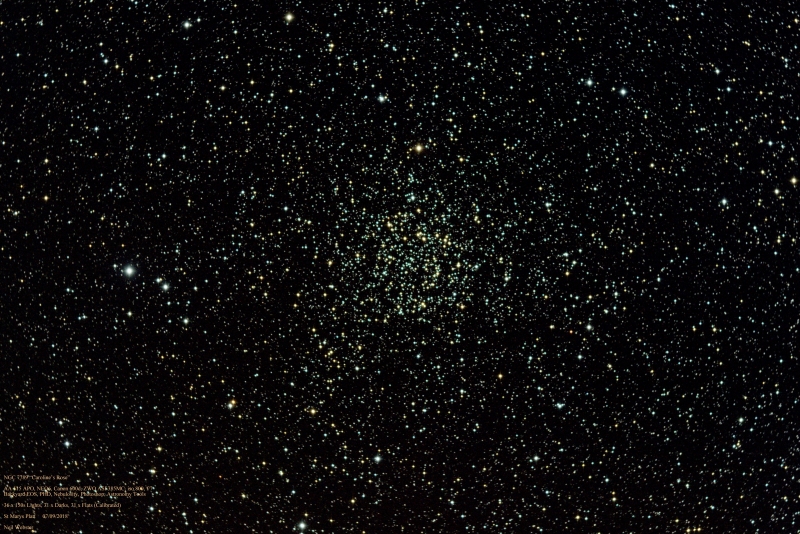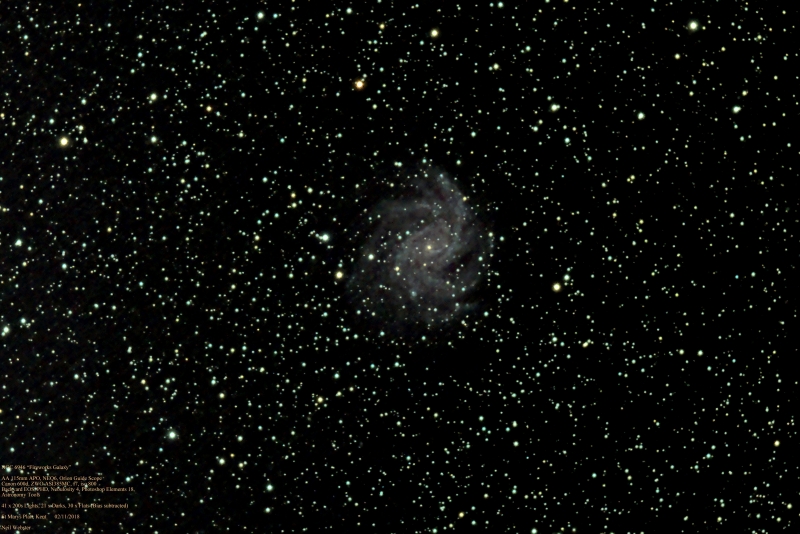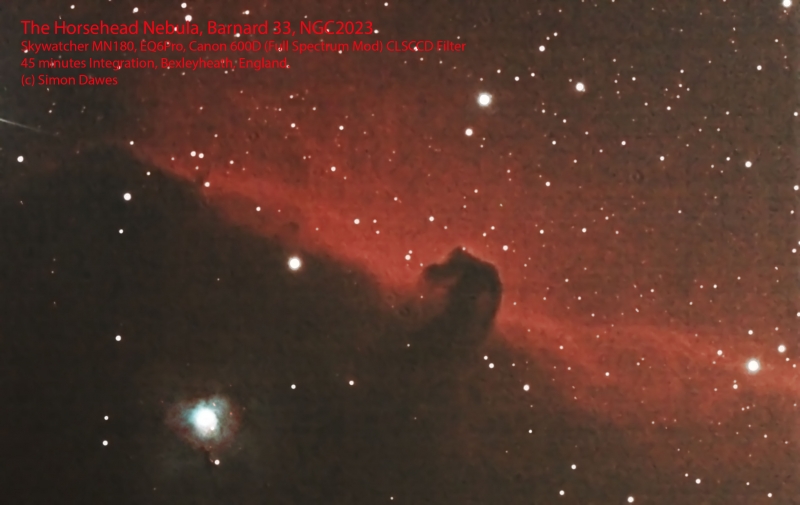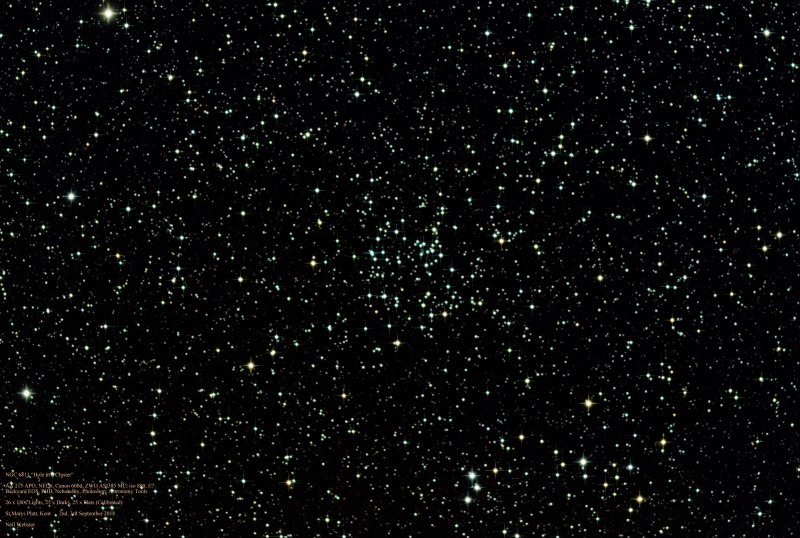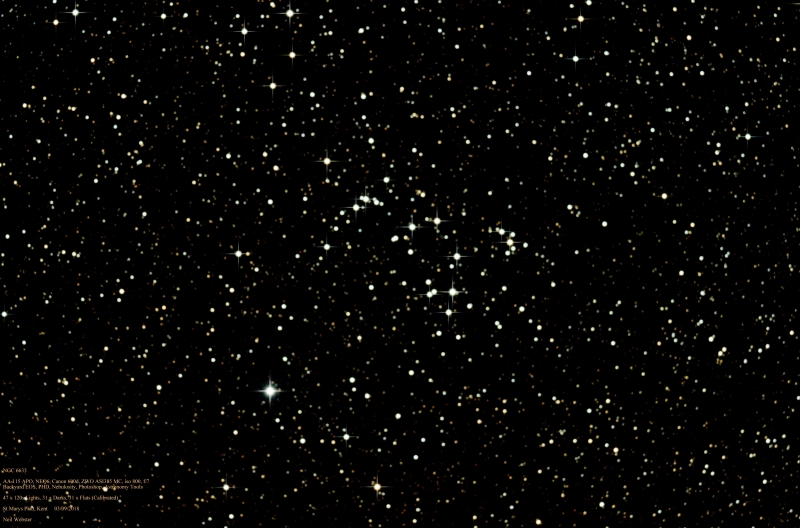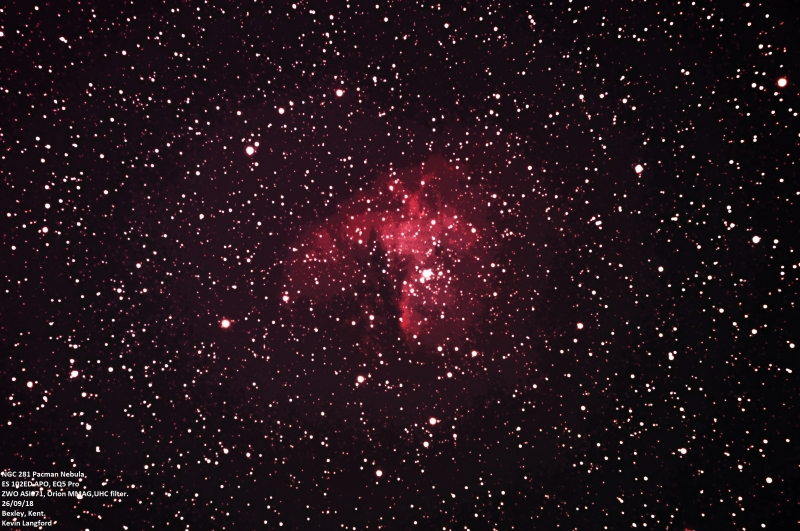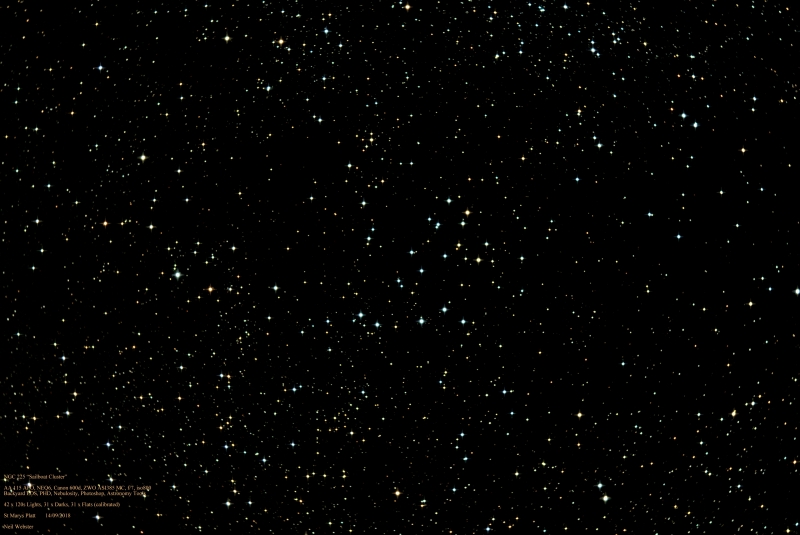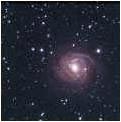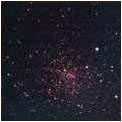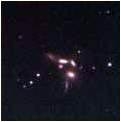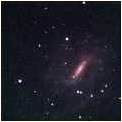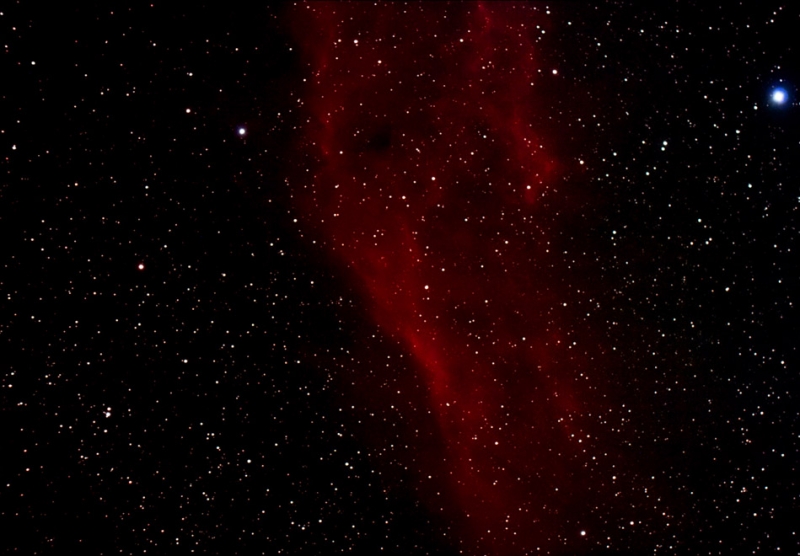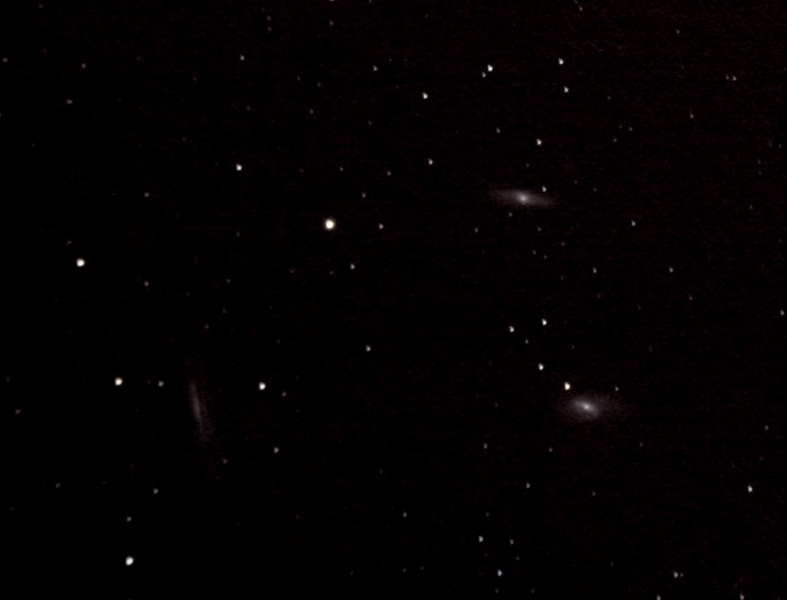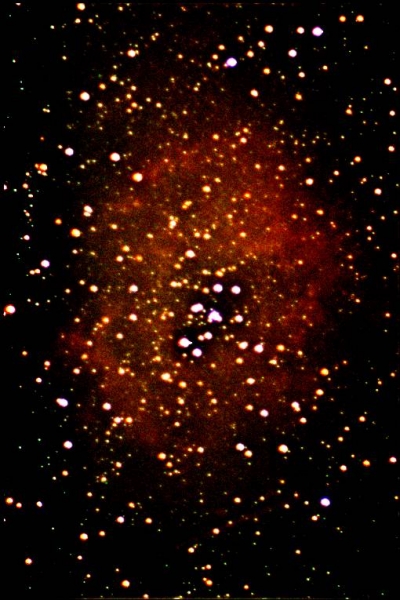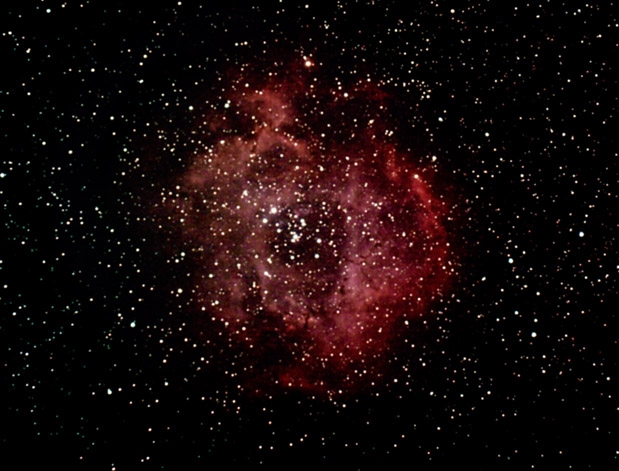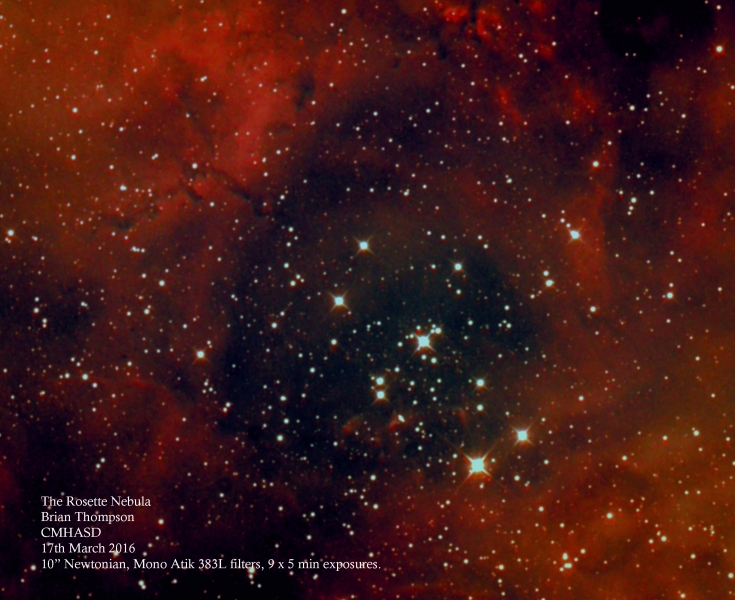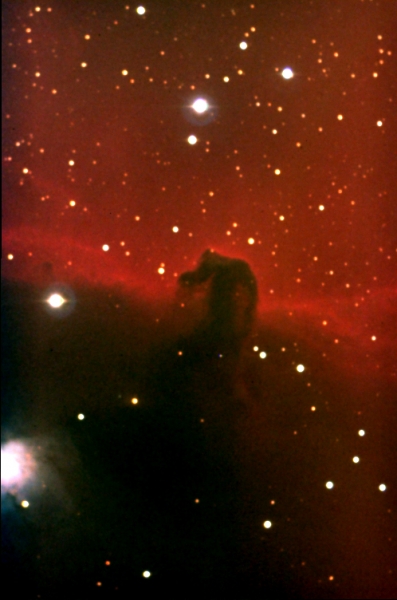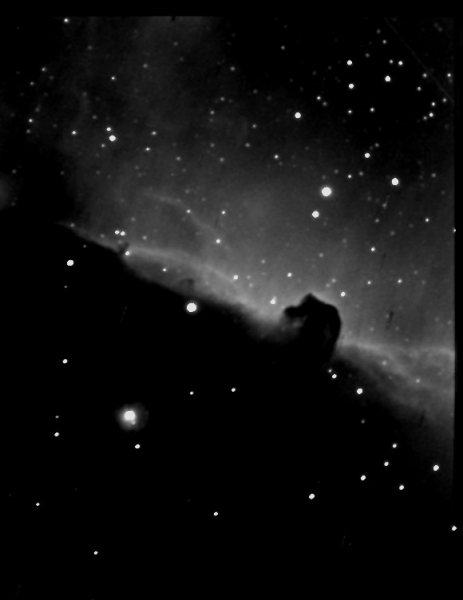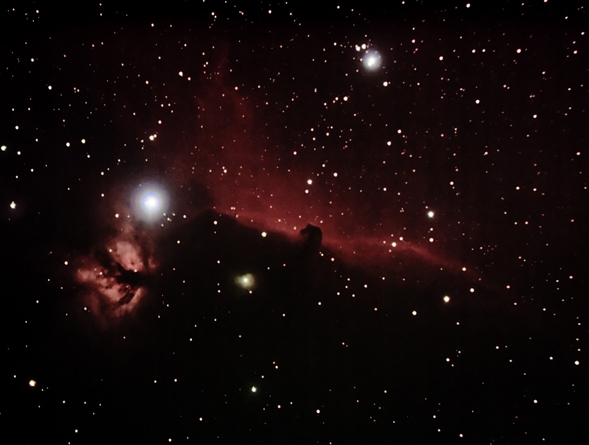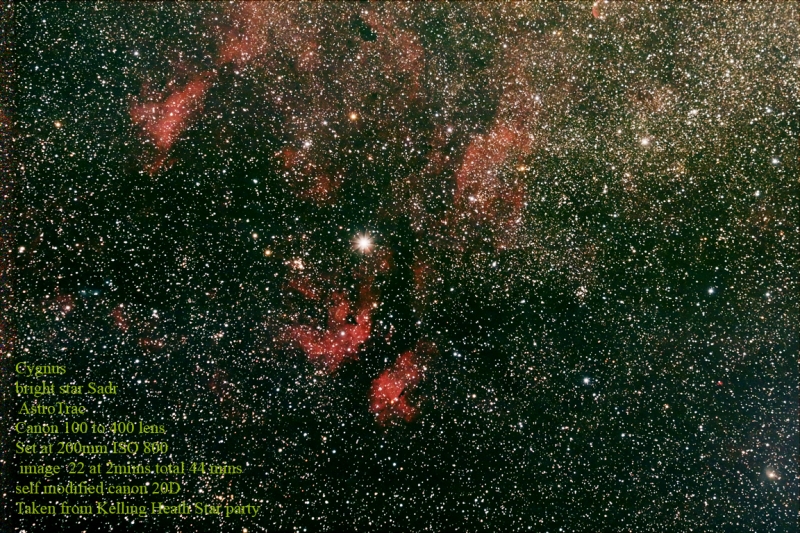So you have observed the Messier and Caldwell objects and want to know what other wonders are out there, the Herschel 400 would be a good start, but if you are after inspiration why not look at what others are observing by having a browse below.
The Rosette Nebula by Neil Webster
A stunning image of the Rosette Nebula (also known as Caldwell 49) in the constellation Monoceros by CMHASD member Neil Webster taken on the 2nd March 2025.

Neil acquired his image using a WO GT71 Apo, EQ6 R, ZWO ASI 294MC Pro, Astro Essentials 50mm guide scope, ZWO ASI 290MM guide camera and an Optolong L Enhance filter.
Processed using APT, PHD, Nebulosity, Gradient Xterminator, Star Xterminator, and PS (Camera Raw)
52 x 240s Subs, 12 x Darks, 45 x Flats/ Bias.
Check out Neil’s Flickr page at https://www.flickr.com/photos/137388222@N05/ to see more of his brilliant images.
IC 434 The Horsehead Nebula by Neil Webster
A wonderful widefield image of the Horsehead Nebula (IC 434) in Orion; taken on the 3rd Feb 2025 by member Neil Webster.

Neil acquired his image using a WO GT71 Apo, EQ6 R, 0.8x Reducer/Flattener, ZWO ASI 294 MC, 50mm Guide Camera, ZWO 290MM Guide Camera, and a Optolong L Enhance filter.
33 x 240s Subs, 10 x Darks, 45 x Flats/Bias
Processed using APT, PHD, Nebulosity, and Photoshop.
Friday 3rd January 2025
NEVER LOOK AT THE SUN DIRECTLY. Please click here for solar observing safely.
A superb selection of member images taken on Friday 3rd January 2025.
The Sun at midday taken by Dr Mike Rushton taken using a Dwarf II smart scope. 20 x 1/250 sec at Gain 0 with a ND6 solar filter.

The Sun taken by Honor Wheeler

The Sun taken by Jim Burchell

The Pleiades by Dr Mike Rushton using a Dwarf II smart scope. 200 x 10sec exposures at Gain 60.

Crescent Moon and Venus taken by Honor Wheeler. Venus is top right of the Moon.

Saturn, Venus and the Moon taken by Honor Wheeler. Venus is top right of the Moon and Saturn is near the top left corner of the image.

The Heart Nebula by Kevin Langford – Jan 2025
This is an absolutely stunning image of the Heart Nebula captured by member Kevin Langford over 2 nights on the 7th and 9th Jan 2025 from Bexley, Kent.
The Heart Nebula (also known as the Running Dog Nebula and Sharpless 2-190) is an emission nebula, 7,500 light-years away from Earth and located in the constellation Cassiopeia. The nebula spans almost 2 degrees in the sky, covering an area four times that of the diameter of the full moon. It was discovered by William Herschel on 3 November 1787.
”The brightest part of the nebula (a knot at its western edge) is separately classified as NGC 896, because it was the first part of the nebula to be discovered. The nebula’s intense red output and its morphology are driven by the radiation emanating from a small group of hot stars near the nebula’s center. This open cluster of stars, known as Collinder 26, Melotte 15, or IC 1805, contains a few bright stars nearly 50 times the mass of the Sun, and many more dim stars that are only a fraction of the Solar mass.” Ref:https://en.wikipedia.org/wiki/Heart_Nebula

Kevin acquired his image using:
ES 102ED APO, 0.7x focal reducer corrector, and EQ5 Pro.
ZWO ASI071, and Orion MMAG,L-eNhance filter.
7.5 Hrs of exposures.
Number of images taken 150 x 180sec.
Software used:
Sirilic to stack images.
Siril to processes image.
Affinity Photo 2 to finish.
Check out Kevin’s flickr page at https://www.flickr.com/photos/77708720@N08/ to see more of his fantastic images.
Thursday 2nd Jan 2025
 Crescent Moon in the sunset taken by Honor Wheeler
Crescent Moon in the sunset taken by Honor Wheeler
 Waxing Crescent Moon & Earthshine by taken Honor Wheeler. The moon was 2.62 days old and 8.35% illuminated.
Waxing Crescent Moon & Earthshine by taken Honor Wheeler. The moon was 2.62 days old and 8.35% illuminated.
 Crescent Moon by taken by John Archer
Crescent Moon by taken by John Archer
 Crescent Moon taken by Dr Mike Rushton using a Dwarf II smart scope. 1/30 sec x 20 at gain 0 and no filter.
Crescent Moon taken by Dr Mike Rushton using a Dwarf II smart scope. 1/30 sec x 20 at gain 0 and no filter.
 The Moon & Venus by taken Honor Wheeler (Venus is in the top left corner)
The Moon & Venus by taken Honor Wheeler (Venus is in the top left corner)
 Orion, Jupiter and Mars by taken Honor Wheeler. Mars is left of Orion and Jupiter is above Orion.
Orion, Jupiter and Mars by taken Honor Wheeler. Mars is left of Orion and Jupiter is above Orion.
 Members observing at the Pavilion on the 2nd Jan 2025 taken by Honor Wheeler
Members observing at the Pavilion on the 2nd Jan 2025 taken by Honor Wheeler

 The Horsehead Nebula taken by Jim Burchell using a Seestar S50 smartscope. 205 stacked images and processed using the Seestar S50 processing software. The Horsehead Nebula (also known as Barnard 33 or B33) is a small dark nebula in the constellation Orion and is located just to the south of the star Alnitak, the eastern most star of Orion’s Belt,
The Horsehead Nebula taken by Jim Burchell using a Seestar S50 smartscope. 205 stacked images and processed using the Seestar S50 processing software. The Horsehead Nebula (also known as Barnard 33 or B33) is a small dark nebula in the constellation Orion and is located just to the south of the star Alnitak, the eastern most star of Orion’s Belt,
 The Pleiades (also known as the Seven Sisters or Messier 45 is a young open star cluster in Taurus) taken by Diane Clarke taken using a Seestar S50 smartscope. 85 x 30sec exposures, Jpeg stacked using Seestar S50 internal software.
The Pleiades (also known as the Seven Sisters or Messier 45 is a young open star cluster in Taurus) taken by Diane Clarke taken using a Seestar S50 smartscope. 85 x 30sec exposures, Jpeg stacked using Seestar S50 internal software.

IC 410 The Tadpole Nebula and IC 405 The Flaming Star Nebula by Neil Webster – 3rd Jan 2025
A superb image of IC 410 The Tadpole Nebula (left) and IC 405 The Flaming Star Nebula (right) by member Neil Webster taken on the 3rd Jan 2025.
”IC 410 is a cosmic cloud that looks like tadpoles swimming through the cosmos.
IC 410 is located 12,000 lightyears from Earth in the Auriga constellation, and is nicknamed the Tadpole Nebula because of the tadpole-shaped clouds of dark dust that appear to be swimming towards the centre. The Tadpole Nebula is a region of ionised hydrogen gas spanning over 100 lightyears across that’s carved and sculpted by streams of charged particles called stellar winds emanating from open star cluster NGC 1893. NGC 1893 is about 4 million years old: the blink of an eye in cosmic terms. The ‘tadpoles’ that give the nebula its nickname are dense streams of dust and gas about 10 lightyears long that may well be sites of star formation.” Ref: https://www.skyatnightmagazine.com/astrophotography/nebulae/tadpole-nebula-ic-410
located near the emission nebula IC 410, is IC 405 (also known as the Flaming Star Nebula, SH 2-229, or Caldwell 31). IC 405 is an emission and reflection nebula that surrounds the bluish, irregular variable star AE Aurigae.

Neil acquired his image using a WO GT71 Apo, EQ6 R, ZWO ASI 294MC Pro Optolong L Enhance filter, Astro Essentials 50mm guide scope, and a ZWO ASI 290MM guide camera.
Processed using APT, PHD, Nebulosity and Photoshop.
58 x 240s Subs, 45 x 0.015s Flats/Bias.
Note: Neil suffered a power cut just before taking the Darks so noise reduction was applied liberally.
Check out Neil’s flickr page at https://www.flickr.com/photos/137388222@N05/with/54245664968/ to see a higher resolution image.
Elephant’s Trunk Nebula (IC1396A) – Oct 12th 2024 by Neil Webster
Shears Green Junior School Cosmic Camp – 27th Sept 2024
On Friday 27th September 2024 several CMHASD members helped out at Shears Green Junior School Cosmic Camp.

Chairman John Archer wrote ”First of all I really want to thank all of the team who supported our evening of outreach last Friday 27th. Once again we attended Cosmic Camp at Shears Green Junior School and were greeted by an enthusiastic audience, most of whom managed to observe Saturn, as well as a number of deep sky objects. There were indoor activities run by Rita and Debra, and the pupils were treated to our slideshow of members’ aurora images. Outside there were a range of scopes – Dob’s, a refractor and also Smartscopes, ably demonstrated by our hardy team including Steve, Dave, Andy, Diane, Mike, Jim & co – thank you all so much for giving up your time and getting involved – it was a wonderful and eventually clear night”.
Below are 2 of the images taken by members whilst at the school that the children saw.
M31 by Dr Mike Rushton using a Dwarf II smartscope with no processing. Stacked image of 200 x 10s exposures at gain 80.
M31 is a barred spiral galaxy and is the nearest major galaxy to the Milky Way. It is also known as The Andromeda Galaxy, Messier 31 and NGC 224. The galaxy is approximately 765 kpc (2.5 million light-years) from Earth. The galaxy’s name stems from the area of Earth’s sky in which it appears, the constellation of Andromeda. Ref:https://en.wikipedia.org/wiki/Andromeda_Galaxy.

M27 by Diane Clarke (with the help of Jim Burchell) taken using a Seestar S50. Stacked image of 224 x 10s exposures. Processed using Affinity Photo.
M27 (also known as the Dumbbell Nebula, Apple Core Nebula, Messier 27, and NGC 6853) is a planetary nebula (nebulosity surrounding a white dwarf) in the constellation Vulpecula, at a distance of about 1360 light-years. It was the first such nebula to be discovered, by Charles Messier in 1764. Ref:https://en.wikipedia.org/wiki/Dumbbell_Nebula.

The North America Nebula (NGC 7000) & the Pelican Nebula (IC 5070) by Neil Webster
Neil’s first Deep Sky image for 18 months…….The North America Nebula & the Pelican Nebula and what a super image it is!
The North America Nebula (NGC 7000) is at the top and the Pelican Nebula (IC 5070) is at the bottom.
The North America Nebula (NGC 7000 or Caldwell 20) is an emission nebula in the constellation Cygnus, close to the star Deneb. It is named the North America Nebula because its shape resembles North America.
”The Pelican Nebula (also known as IC 5070) is an H II region associated with the North America Nebula in the constellation Cygnus. The gaseous contortions of this emission nebula bear a resemblance to a pelican, giving rise to its name. The Pelican Nebula is located nearby first magnitude star Deneb, and is divided from its more prominent neighbour, the North America Nebula, by a foreground molecular cloud filled with dark dust.” Ref:https://en.wikipedia.org/wiki/Pelican_Nebula

Neil acquired his image on the 27th Sept 2024 using a WO GT71 apo, EQ6-R, ZWO ASI 294MC Pro, Optolong L-Enhance filter, Astro Essentials 50mm guide scope & ZWO ASI 290MM guide camera.
Processed in APT, PHD, Nebulosity, Photoshop and Star Xterminator
38 x 240s Subs, 12 x darks, 45 x flats/bias
For a more detailed view of Neil’s image check out his flicker page at https://www.flickr.com/photos/137388222@N05/54032311437/
NGC 6992 & NGC 891 by Jim Burchell
Two excellent deep sky images taken by Jim Burchell on the 14th Sept 2024 of NGC 6992 and NGC 891 using his Seestar S50 smartcope.
The Veil Nebula is a cloud of heated, ionized gas and dust in the constellation Cygnus. It constitutes the visible portions of the Cygnus Loop a supernova remnant. Sections of the Veil Nebula have their own individual names and catalogue identifiers and NGC6992 is a bright area in the Eastern Veil (also known as Caldwell 33) of the Veil Nebula.
The image is made up of 138 x 10 second stacked images. Then processed in Snapseed.

”NGC 891 (also known as Caldwell 23, the Silver Sliver Galaxy, and the Outer Limits Galaxy) is an edge-on unbarred spiral galaxy about 30 million light-years away in the constellation Andromeda. It was discovered by William Herschel on October 6, 1784.” Ref:https://en.wikipedia.org/wiki/NGC_891
This image is made up of 48 x 10 sec stacked images. Then processed in Snapseed. Ref:

Other Images
Sun | Comets | Mercury | Venus | Atmospheric Optics | Meteors | Auroa and NLC | Moon | Minor Planets | Mars | Jupiter | Saturn | Uranus | Neptune | Messier | Caldwell | All Deep Sky | Conjunctions | Transits | Solar Eclipse | Lunar Eclipse | Wide Field |ISS & Space Junk | Exo-Planets
All images are copyright. Permission must be sought to from the image owner to the use of any of these images.


